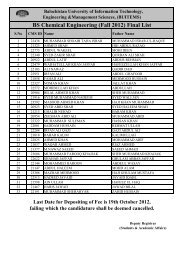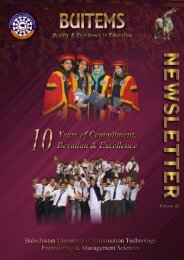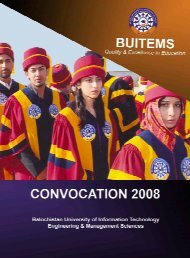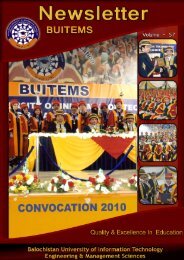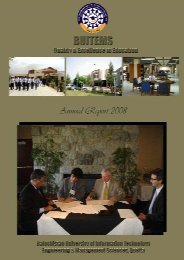BUITEMS
Research Journal - buitems
Research Journal - buitems
- No tags were found...
You also want an ePaper? Increase the reach of your titles
YUMPU automatically turns print PDFs into web optimized ePapers that Google loves.
<strong>BUITEMS</strong><br />
Quality & Excellence in Education<br />
Investigating the Mechanical Properties and Drill-ability of Rocks<br />
collected for laboratory testing should be in<br />
the form of large blocks from the field [11]. In<br />
instances where substantial drilling is<br />
required to evaluate a deposit, it is usually<br />
considered to be good practice to core a<br />
certain percentage of holes in the drill<br />
program. The actual percentage will vary with<br />
the available budget and the degree of<br />
complexity of the geology, but usually<br />
average about 10% core samples offer the<br />
advantage that sample location can be<br />
closely defined, and there is little possibility<br />
of contamination or loss of values as long as<br />
recovery is good. On the negative side, core<br />
drilling is expensive and usually the sample<br />
obtained is relatively small. In case where the<br />
ore boundaries are fairly well known, the cost<br />
can sometimes be lowered by rotary drilling<br />
to near the ore boundary and then continuing<br />
with core. Rebound and rebound of diamond<br />
tipped impactor hardness is calculated by<br />
Shore Sceleroscope Hardness Test (Figure<br />
1) .Rebound hardness is calculated by<br />
Schmidt Hammer Hardness Test (Figure 2)<br />
which impacts the piston striking. This test<br />
was first used for rapid examination of<br />
compressive strength of concrete and later it<br />
was used to calculate the hardness of rock.<br />
UTM (Universal testing machine) (Figure 3)<br />
is used to determine UCS (UNI-AXIAL<br />
COMPRESSION TESTING) which is the<br />
most basic parameter of rock strength, and<br />
the bore ability prediction is performed by<br />
using UTM [8]. It is calculated in accordance<br />
with instructions given in ASTM (American<br />
Society for Testing and Materials).<br />
1. Level Rod<br />
2. Level Adjust Screw<br />
3. Main Body<br />
4. Table<br />
5. Control Knob<br />
6. Operation Knob<br />
7. Indication Scale<br />
8. Butt Gage Fixed Handle<br />
9. Hole For Butt Gage<br />
10. Dial Gauge Fixed Screw<br />
Figure 2 – Schmidt Hammer<br />
Figure 1 – Shore Sceleroscope<br />
Figure 3 - Universal Testing Machine (UTM)<br />
60



